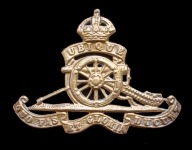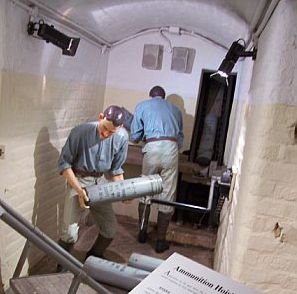|
7 Coast Regiment

The 7th Heavy Regiment were at Singapore on 24th February 1939, it was re-designated as 7th Coast Regiment on 18th December 1940, disbanded February 1942, lost at Singapore.
Comprised of 4 Battery's:-
- 11th RA
- 31st RA
- 5th HKSRA
- 7th, HKSRA.
The 7 Coast manned guns at:-
- Beting Kusha Battery - 2x6inch guns
- Johore Battery- 3x15inch guns, two of which were used against the Japanese as they could be turned to target them on Johore and Singapore.
Replica of the monster gun and 15-inch shell site at the Johore Battery
Built by the British in 1939 for the defence of Singapore, the guns were the largest installed outside Britain during WWII. The Johore Battery is a gun emplacement site consisting of a labyrinth of tunnels. The tunnels were used to store ammunition to support three large guns that could fire 15-inch shells.
Five big 15 inch guns were installed in Singapore-three in Changi and two in Buona Vista. The three guns in Changi formed the Johore Battery. It was called the Johore Battery because the sultan of Johore gave King George V £500.000 for his Silver Jubillee in 1935. The British used £400.000 of the gift to install to guns in Changi, which in 1942 was used to shell Johor Bahru.
Each of Johore's Battery's guns had its own ammunition bunkers. These were about 500 metres apart, arranged in a line that stretched from the present site onto what are now the runways of Changi Airport. Though these guns were originally intended to stop an attack from the sea, two of Johore Battery's guns could turn around and fire to the rear, towards Johor Bahru. The third, the one located at this site, could only fire out to sea.
From 5th to 12th February 1942, the two guns of the Johore Battery that could turn around fired landward in Singapore's defence. They shelled Japanese infantry positions from Johor Bahru, just across the Causeway, eastwards to the area North of Tanjong Punggol. They also joined in the battles for Bukit Timah Road and Pasir Panjang. The guns of Johore Battery fired 194 rounds before their demolition by the British on the night of 12th February. This demolition, and the postwar upgrading of Changi aerodrome, means all the remains are the underground tunnels on this site, which once housed ammunition and power plants.
The guns were destroyed before the surrender of the British army and the tunnels were sealed up after the war. The location remained a secret until the Singapore Prisons Department rediscovered them in April 1991.
The 7th Coast Battery was within the 9th Coast Regiment, manning the 15inch guns of Jahore Battery, and the 22nd Battery manning the 9.2inch guns on Pulau Tekong, being the nearest to the mainland.
After the causeway was blown the 7 Coast’s 31 Battery RA and 7th Battery HKSRA were situated on the West side of Singapore City.
Blakan Mati Command Post (Reconstruction)
At the time of surrender the part of the 7/11 Coastal regiments were on Berhala Repping ( which was about 100 feet from Blakan Mati and is now part of the same island of Sentosa due to reclamation).
Blakang Mati Island lay the seaward side of Keppel Harbour along the south coast of Singapore Island, it sheltered the harbour from the sea. It was on the summit and the seaward side of Blakang Mati which accommodated some of the much-talked about Singapore defences that looked out to sea.
|

|
|
Reconstruction of the ammunition hoists at Blakan Mati
|
|
.If the Japanese had done what was expected and attacked Singapore from the sea, the guns would have been instrumental in repelling them, instead they arrived by Malaya, and there was little that Blakang Mati or any of the other coastal defences could about it to any great extent.
There were several attempts of escape, Capt T.E. Pickard's boat and two other "tonkangs' which left Blakan Mati around midnight on 16th February 1942 - each with about 20 men (it is believed there was a mix of 7th Coastal and FMSVF) but Pickard, when he wrote his report on 2nd April 1942 in Colombo, did not know what had become of them, but it is believed one group were killed by the Japanese on their way to Sumatra. The ‘Knightingale’ (M.L.) was one of the craft which left Blakang Mati with Capt Kirkwood, R.A.M.C., and his staff.
Those of the 7 Coast captured had a rough time in captivity, with some appalling losses on the Thailand-Burma Railway, hell ship sinkings, plus the 600 Gunners Party which met its fate on Ballali Island, these added many of their names to the death roll.
|